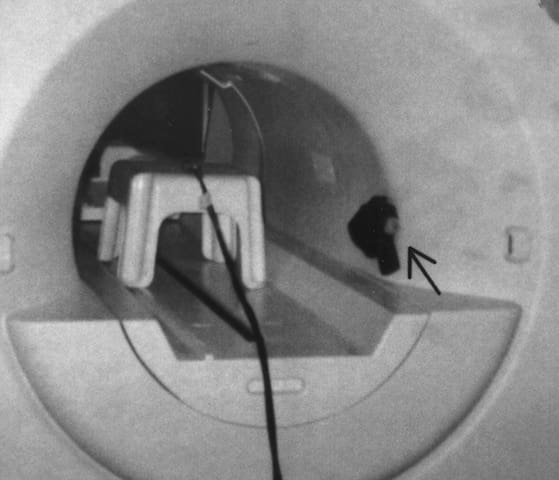Spontaneous Discharge of a Firearm in an MR Imaging Environment. It may not rival US magazine’s coverage of Katie Holmes alleged drug addiction, but the article in the Journal Of Roentgenology is a fascinating read nonetheless. “An off-duty police officer went to an outpatient imaging center (not affiliated with our institution) in western New York State to have an MR imaging examination. The facility housed a 1.5-T MR unit (Signa; General Electric Medical Systems, Milwaukee, WI) with active shielding. The officer was carrying a model 1991 A-1 compact.45 caliber semiautomatic pistol (Colt’s Manufacturing, Hartford, CT).” Guess what happens next?
The officer notified the technologist that he was carrying the weapon before entering the MR dressing room. The technologist told the officer to take the gun with him. The technologist intended to meet the officer in the MR patient waiting area before the examination and secure the weapon in that room, where he felt it would be safe. However, the officer apparently misunderstood and took the gun into the MR suite. The technologist was entering the officer’s personal data into the computer and did not see him entering the MR suite.
Once the officer was inside the MR suite, the gun was pulled from his hand as he attempted to place the gun on top of a cabinet 3 ft (0.9 m) away from the magnet bore. The gun was immediately pulled into the bore, where it struck the left side and spontaneously discharged a round into the wall of the room at the rear of the magnet. Fortunately, no one was injured. Although the gun struck the magnet bore, only minimal cosmetic damage occurred to the magnet itself. The MR unit had full functional capability immediately after the gun discharged. The weapon’s thumb safety was reportedly engaged when the gun discharged.
Thank God the 1.5-T MR was safe! And yes, the 1911 was “cocked and locked.”
The gun likely discharged as a result of the effect of the magnetic field on the firing pin block. The firing pin block was probably drawn into its uppermost position by force of the magnetic field. The firing pin block has to overcome only light pressure from a relatively small spring to release the firing pin. The pistol was likely drawn into the magnetic field so that the muzzle struck the magnet’s bore first. With the firing pin allowed to move freely in its channel, the force of the impact on the muzzle end was sufficient to cause the firing pin to overcome its spring pressure and move forward to strike the primer of the chambered round.
And what did we learn from this? Don’t bring a gun to an MRI fight.





Don’t bring your wallet either. It’ll wipe all your credit and debit cards into useless plastic rectangles.
My debit cards are already useless, plastic rectangles, but that’s because I have no money.
The other thing we learned is carry a double action only gun. I’ve never liked cocked and locked.
Perhaps I read it incorrectly, but according to the story the firing block was moved out of position by the magnetic field. The force (aka impact) of the pistol hitting the inner wall of the MRI caused the firing pin to come forward with enough force to strike the primer and ignite. I don’t think DA vs SA applies here. I bet it is even possible for a striker-fired pistol to do the same, save of course if the firing pin block is made of aluminum or polymer.
The solution is very simple, folks. If you must carry a firearm into an imaging center, carry a Glock, since they are all plastic, right???
Perhaps we learned that we were right in the first place. There’s no such thing as an accidental discharge. Having brought that gun near the machine through ignorance is no excuse. There was human error.
I would agree. However, 99.99999% of the other NDs were due to people not being smart enough to keep their booger hooks off of the bang switch until they really wanted to, you know, fire the gun. This seems like just about the least amount of culpability on the part of the owner possible.
I have always held that a gun cannot “go off”, accidently.
Unless someone can tell me how a round gets in the chamber “accidently”?
That round gets placed in the weapon by the human handling it, wild guess?
Some of the most unsafe folks I’ve ever been around are avid hunters who,”ah, I’ve hunted for years and never had a accident”, providence or plain luck.
I demonstrated this to a police officer in school. Gun safety, excellent, and I challenged him a weapon won’t go off accidently. He took me up on it. Handed me his pistol, unloaded, I pretended to unload it for the demonstration. Handed it back to him and said now, make this weapon go off accidently!!!Nuff said
Comments are closed.